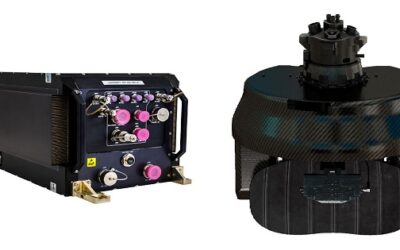MONCh interviewed Shrike Marine on their power saving technologies
MONCh: Why is energy management critically important nowadays for land systems, ships and even air frames?
Rhian Guthrie (Business Development) and Drew Guthrie (Research & Development): The demand for increasingly complex technology solutions is relentless, both militarily and commercially. Modern war-fighting operations require highly sophisticated, power-hungry electronic packages to support mission-critical command, control, communications, computers, intelligence, surveillance and reconnaissance (C4ISR) domains as well as traditional mechanical subsystems.
With advanced technology solutions comes an ever-increasing power demand and the need to manage this power more efficiently. Energy becomes a logistical stumbling block limiting the duration of tactical deployment, and until there is a breakthrough in energy storage technology, efficient generation, distribution, conversion and conservation of energy are critical success factors. Size and weight considerations further constrain the boundaries of energy management for modern fighting platforms
MONCh: How is SHRIKE a “force multiplier” for land and naval forces?
R&DG: If a technology can be used to increase the effectiveness of a fighting platform through the application of more sophisticated electronic mission packages, or by more efficient energy management or by decreasing logistical support requirements, such a solution becomes a force multiplier.
Critical to the next generation combat vehicle (NGCV) is modularity. The platforms need to be modular enough to accept a wide variety of weapons systems. This requires rack-based power management solutions, easily changeable and automatically configurable. Such solutions are interoperable and close enough in capability for training commonality.
SHRIKE’S philosophy and attention is directed towards addressing specific power system architecture to provide open, distributed, flexible and modular solutions supporting integration and management of multiple inputs, weapons, communications and combat platform management systems in an energy and space efficient manner.
MONCh: What are the advantages SHRIKE can bring to a military’s land system in terms of cost and energy efficiency?
R&DG: SHRIKE endeavours to provide innovative and tailored power management solutions for defence-related platforms. Working off a low overhead base, the company is able to address the needs of modern fighting vehicle functions more cost-effectively than larger competitors while still ensuring GVA compliant solutions drive down longer-term procurement, operational and sustainability costs. Energy efficiency is addressed through a coordinated systems approach to the development of specific platforms.
While modern technology battlefield solutions are high energy consumers, fully customisable electronic control innovations allow intelligent and autonomous power switching between modes and states to ensure applicable systems are operating at optimum efficiency to support current tactical status.
SHRIKE also provides an essential rear echelon communication component to keep brigade headquarters continuously apprised of each vehicle’s fighting state of readiness.
Combat vehicle modernisation initiatives must provide lighter, more reliable vehicles to increase expeditionary capabilities. Lower weight vehicles, more reliable and repairable components and more energy efficient systems result from the elimination of conventional legacy circuit breakers and bulky wiring systems.
MONCh: What sort of savings (per cent?) can defence establishments’ accountants expect over previous year’s energy costs and consumption without SHRIKE?
R&DG: We are unable to gauge escalation in energy costs and consumption for a total military vehicle formation especially as legacy platform modernisation initiatives usually mirror budgetary uncertainty and fiscal constraints of the military authorities. But it is fair to say that the electrical demands of war-fighting platforms is increasing exponentially.
But if we draw a parallel with commercial jet-liner fleets, new aircraft are now 70 per cent more fuel efficient than 40 years ago and 20 per cent better than 10 years ago. Applying the same principles of innovation, incremental technological improvements and advanced electronic system controls to next generation combat vehicles will provide greater mission effectiveness with maximum efficiency to offset increasing electrical demands.
Our systems ability to monitor and manage current consumption will allow vehicles to run tactically for longer. And more sophisticated battery management means longer lasting batteries and the use of more complex chemistries, offering advantages in size and weight.
MONCh: What can SHRIKE ensure its industrial partners (i.e. prime contractors) and their customers? Especially, as more navies look to replace older inefficient ships with “all electric ships” – or, upgrade older ships with new technical infrastructures…
R&DG: SHRIKE’S philosophy is to work collaboratively with our business partners to provide original, intelligent and tailored solutions to defence-related power management challenges.
Recognising the needs of military modernisation initiatives, we strive to provide open, distributed, flexible and modular solutions – simple, easy to install, plug-and-play modularity requiring less soldier training to install and maintain. We look for commercial off-the-shelf products where available to limit risk, reduce development time and to build on proven technology.
We provide easy fault-finding during system integration to protect equipment from damage.
SHRIKE does not have the capability of modernising warships but is happy to work with business partners to provide specific technology solutions relating to power distribution and management.
MONCh: Is the SHRIKE system solution one of those remarkable technologies that can support commercial logistical and passenger vehicles as much as it can armoured vehicles and ships?
R&DG: Many commercial vehicle manufacturers are already ahead of the curve exploiting the latest enabling component technologies that have the potential to dramatically change the approach to basic combat vehicle design. Mobile apps assist repair technicians in identifying potential repair and maintenance issues before they occur.
This is an especially important breakthrough for large fleet management and has application in the military theatre where vehicles may be required to be unused and unattended for long periods of time.
Technologies planned for longer-term implementation include the adoption of autonomous (manned and unmanned) systems.
SHRIKE’S vehicle power management system has limited application in modern commercial and passenger vehicles, except where such vehicles need to be equipped with high power demand ancillary systems, for example, ambulances and similar emergency vehicles.
























